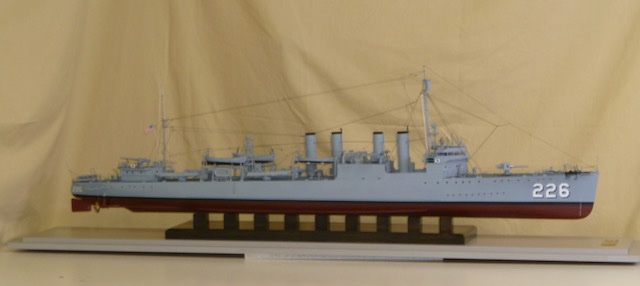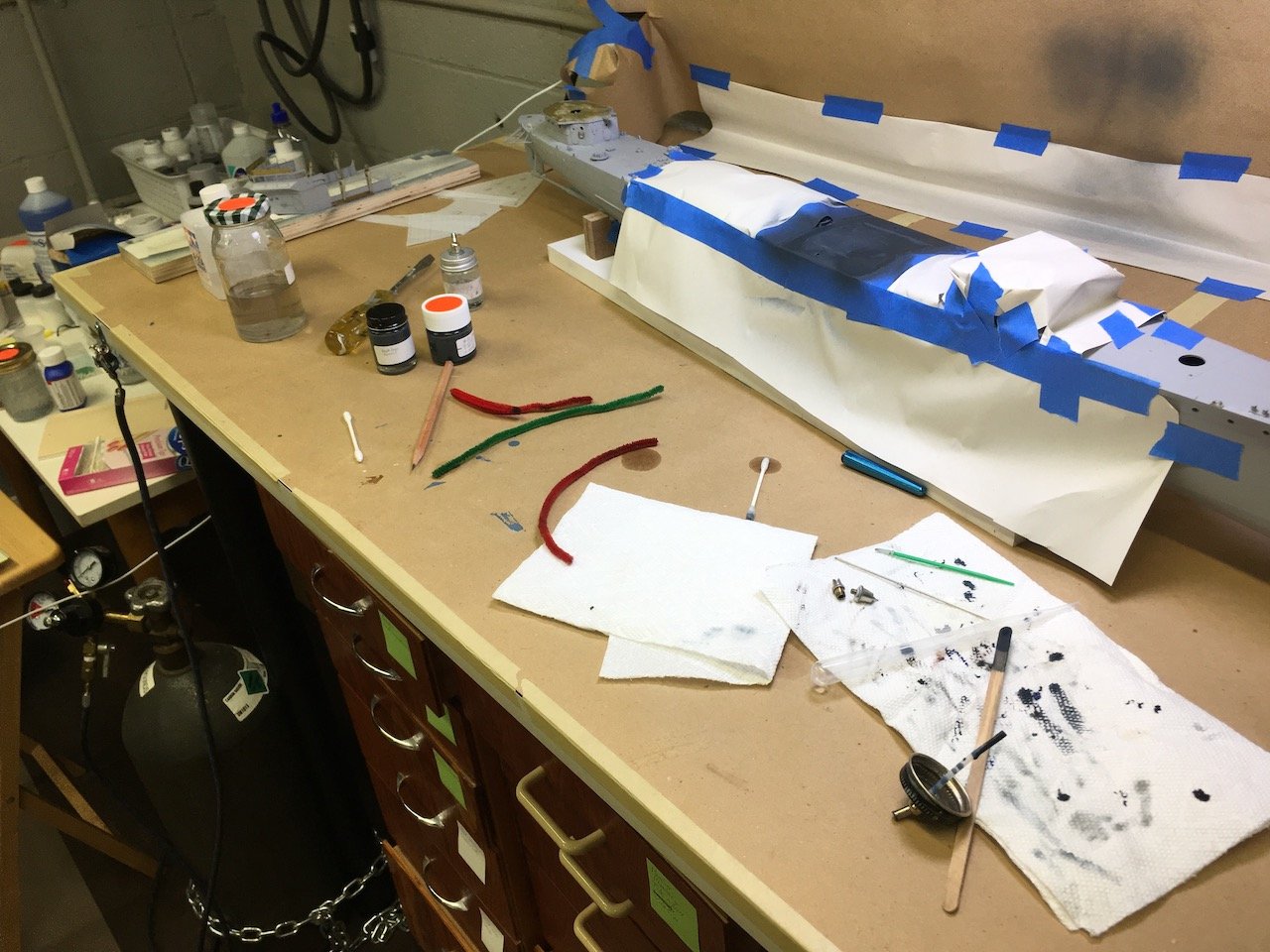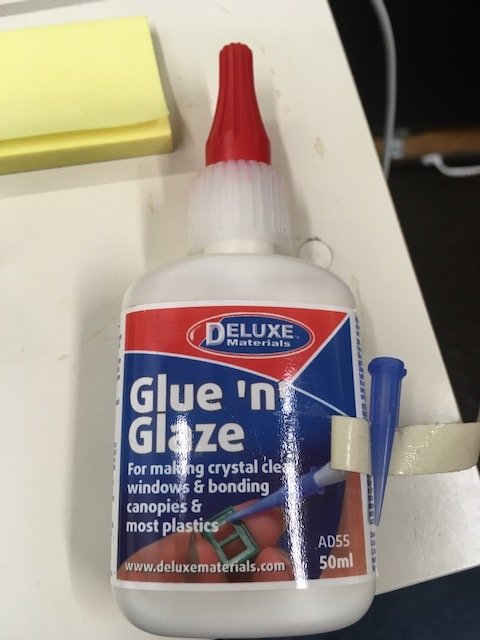-
Posts
183 -
Joined
-
Last visited
Content Type
Profiles
Forums
Gallery
Events
Everything posted by rcweir
-
David, those pumps look great as does the decorative molding.
- 43 replies
-
- Mayflower
- Model Shipways
-
(and 1 more)
Tagged with:
-
This is wonderful! (I am working very, very, very slowly on this same model in hopes of completing at least one sailing ship before I expire!) The points you've highlighted, especially the crows nest is a problem ahead of me and your detailed solution is going to be a great aid. You mention the divergence between Chuck's prototype in the instructions with the kit we have before us: I think that's my greatest disappointment with the kit. It seems unfair to provide instructions that illustrate what one might be able to do with top grade materials and more experience - what a relatively inexperienced modeler (e.g. me) wants to know is how to best use the materials actually supplied. (As an aside, I am located in Massachusetts and have been able to take many photos of Mayflower II in its recent large overhaul. It's way too much to just post on the forum but if anyone's looking for something specific, pm me.)
- 43 replies
-
- Mayflower
- Model Shipways
-
(and 1 more)
Tagged with:
-

4" Sliding Bevel Required
rcweir replied to Some Idea's topic in Modeling tools and Workshop Equipment
Lee Valley Tools has one (and it's not cheap): https://www.leevalley.com/en-us/shop/tools/hand-tools/marking-and-measuring/bevels/114778-crucible-sliding-bevel?item=97K5033&utm_source=free_google_shopping&utm_medium=organic&utm_campaign=shopping_feed&gclid=CjwKCAjw_ISWBhBkEiwAdqxb9v8QHz5gG_a8pU9l7OqTYPrsuCX4IIFI5HNeHEE9paukkYWovQMVvhoCjTcQAvD_BwE I don't have this myself though I've found Lee Valley to be a trustworthy source. -
The publisher of the 1963 edition, at least for the US, is Holt, Rinehart and Winston. The first paragraph of the acknowledgements says "The Lore of Ships has been designed by Tre Tryckare, Cagner & Co., and is based on the ideas and plans of EWERT CAGNER." I'd never noticed that and for all these decades have thought that Tre Tryckare was a real person! I agree that it's an amazing compendium of information.
- 4 replies
-
- Review
- Book Review
-
(and 2 more)
Tagged with:
-

Vietnam-era Navy Haze Gray
rcweir replied to Viojase's topic in Painting, finishing and weathering products and techniques
The ModelWarships forums are great for a question like this. In particular, look at this thread: http://www.shipmodels.info/mws_forum/viewtopic.php?f=69&t=104955 But I wouldn't burn my brain up on the topic: for my own model of a mid-1970s USN frigate I used Liquitex Neutral Gray and I think it looks perfect. For a WWII model I had 4 different paint chip cards to work from for hull colors and none of those cards looked very much like the others. So I felt free to mix my own. But the post-war haze gray is such a neutral color that I think most any premixed, neutral medium gray will be fine and mixing can easily be avoided. -
That's all quite true but it would be a mistake to leave readers with the impression that Mr. Baker was just an imaginative enthusiast. He was both an experienced naval architect and an historian and he has described in detail the way he arrived at his design for Mayflower II. In his writing I think he's been clear regarding the cases where modern necessities forced him away from what he understood to be 17th century practice. Two of his books, The New Mayflower (Barre 1958) and The Mayflower and Other Colonial Vessels (Conway 1983) are both pretty easy to find from online used book dealers and they describe the bases for his design and the various decisions he had to make to produce a real ship. Plus, for those interested, The New Mayflower came with 1/8":1' scale plans for a version of Mayflower II that omit the adjustments he made to the 20th century replica.
-

Byrnes saw extension….
rcweir replied to geneinmurphy's topic in Modeling tools and Workshop Equipment
I'd be interested in ideas about that, too. Thus far I've just been lazy and let things fall off the end - seeing some ideas about what to do might spur me on to actually build a solution. -
Absolutely! When I can, I try hard to get the original printing of older volumes for this reason, because the original drawings are much sharper, and also because the original bindings are usually much easier to work with than reprints (Dover reprints are usually bound in a way that's especially hard to use). (I've never found a reprint of anything that feels as good in the hands as the original edition.) I have had great experience finding old editions at excellent prices through bookfinder.com, or sometimes through one of the other sites that bookfinder uses (notably biblio.com). And I make an effort to avoid buying such things through Amazon; you'll usually find the dealers' listings through various sites at somewhat different prices. In a case like this Amazon offers no benefit and I want to support the independents as much as I can. Remember, in many many cases a patient search can get you the first edition for no more money than a new reprint.
-
On the topic of Van de Velde drawings only, there's a two volume folio set published by Cambridge University in 1973. I have vol 1 (National Maritime Museum drawings) with all 745 drawings illustrated. Vol 2, which I haven't seen, covers "the Ingram Collection". The full title of my volume is "Van de Velde drawings; a catalogue of drawings in the National Maritime Museum made by the elder and the younger Willem Van de Velde."
- 7 replies
-
- Marine artist
- Dutch
-
(and 2 more)
Tagged with:
-

Advice wanted - best way to display trumpeter Bismarck 1/200
rcweir replied to AlShamed's topic in Plastic model kits
I go though this question anew on every model, but usually end up with more or less the same solution, i.e. raise the model up on something in the spirit of keel blocks set on a nice piece of wood. I think models look better raised above the mounting board and my keel blocks (which are decorative, not intended to be accurate models) make it easy to hide the screws that fasten the model to the base. I have attached a couple of photos of a model in the size range that you are dealing with. In this case the wood base and blocks are ebonized walnut. The wood base is mounted to an MDF base painted gray. The MDF holds the plexi enclosure and I wanted it to be unobtrusive. The plexi is not fastened to the MDF. -

To add sails or not? What is your preference?
rcweir replied to Bill97's topic in Masting, rigging and sails
Constitution has been under sail in the no-too-distant past. There are plenty of pictures on the web of her under sail (on a distinctly non-windy day), soon after leaving a recent overhaul. I think that they may not have the nerve to do that again. Bob -
The William Baker plans show the capstan on the Upper Deck about 10' aft of the mainmast, and as you'd expect that is where it is on Mayflower II (built from Baker's plans). It's darned hard to find pictures on the web of the capstan. But I plan to drive down to Plymouth next week or the week after and, to the extent I can, take photos of details like that.
-
You're doing a great job, Jonathan. This is a model that I'd love to build myself ,so I'm watching closely. I appreciate your superb photos - a great photo really helps your work come alive. Bob
-
That's whose I used in 2018 (for 1:96, hi-vis) decals, but I got them through floatingdrydock.com. They were perfect for my need. Bob
-

AIRBRUSH OPINIONS PLEASE...
rcweir replied to MadDogMcQ's topic in Painting, finishing and weathering products and techniques
I have a photo that's not so good, but you can see it all. The bottle is on the lower left with a bar regulator (so-called, I think, because it's used for dispensing beer). Directly above it, hanging from the corner of that bench is my airbrush. Not easy to see. Various of my cleaning supplies are strewn across the bench top. Incidentally, I always use a respirator when I spray paint, just to be safe. It's all part of my ritual of painting so I don't even think of it as a nuisance. I clean with 91% isopropyl alcohol for the most part. Bob- 40 replies
-
- best airbrush
- compressor
-
(and 1 more)
Tagged with:
-

AIRBRUSH OPINIONS PLEASE...
rcweir replied to MadDogMcQ's topic in Painting, finishing and weathering products and techniques
I have a Badger 150 that has served me well (when I've needed it) for many years. When I got it I was living in an apartment and the noise of a compressor was unacceptable, so I started with CO2 and have stuck with it. CO2 is silent and there are no concerns about moisture in the supply, though I don't think this is the cheapest route for a heavy user. However, since there are often years in between my uses, that hasn't ever mattered much. I hate the racket from compressors! I use acrylics (Tamiya) exclusively and completely disassemble and clean the brush after every single use. Trying to shortcut cleaning has never worked for me.- 40 replies
-
- best airbrush
- compressor
-
(and 1 more)
Tagged with:
-
I have a Model Shipways kit for the US Brig Niagara that I don't think I'm ever going to build. I'm offering it for free except for postage to anywhere in the US (if you're near Lexington, MA you can just come by and pick it up). The kit was new when I got it 2-3 years ago but my interests have wandered from the era. The box has been opened but all the parts packages are still sealed. I believe it is 100% complete. PM me if you are interested.
-
I used "Glue 'n Glaze" successfully on both brass and resin surfaces. It's been about a year so far on the Peary and still looks good. The brass was painted beforehand with acrylic. Bob
-

Laying out plans in a smaller workshop
rcweir replied to alde's topic in Modeling tools and Workshop Equipment
I have known magnetic lamps hung overhead to let go if bumped. The ones on my bandsaw and drill press like to do this just to hear me curse. Bob -
The original question got me to wondering about the use of continuous non skid pathways vs. the rectangular "tread strips" that we often see in pictures of US Navy ships in the WWII era. I looked in what references I have, but turned up very little. In "Fletcher-Class Destroyers" by Alan Raven there's a plan of the main deck and O1 level on pp. 84-85. The caption there says "General Arrangement of Main & Superstructure Decks Showing Layout of Non-Slip Walkways Laid onto the Decks. Although this arrangement was generally followed, there were many exceptions, as shown in the photos of deck views." And in "The Floating Drydock's Plan Book The Fletcher Class" on p. 117 there's a photo from Oct 1944 of USS Norman Scott (DD 690) which says "Like many ships, she had deck tread strips added rather than solid walkways." My takeaway from this meager information is that one is not likely to know what the ship being modeled had without contemporary photos of it. For information about the materials, this link looks like a great starting point: https://www.shipcamouflage.com/painting_and_cementing_chapter4.htm#Miscellaneous Items Bob
-
Tehnoart (based in Riga, Latvia) had a limited edition resin/brass/fiberglass kit of Endurance out a couple of years ago. Unfortunately the company is no more and I think there were only a dozen or two kits available of that ship. This is a link to an article about one build of that kit: https://www.expeditions.com/blog/edurance-model-ship-ken-greenwood/
About us
Modelshipworld - Advancing Ship Modeling through Research
SSL Secured
Your security is important for us so this Website is SSL-Secured
NRG Mailing Address
Nautical Research Guild
237 South Lincoln Street
Westmont IL, 60559-1917
Model Ship World ® and the MSW logo are Registered Trademarks, and belong to the Nautical Research Guild (United States Patent and Trademark Office: No. 6,929,264 & No. 6,929,274, registered Dec. 20, 2022)
Helpful Links
About the NRG
If you enjoy building ship models that are historically accurate as well as beautiful, then The Nautical Research Guild (NRG) is just right for you.
The Guild is a non-profit educational organization whose mission is to “Advance Ship Modeling Through Research”. We provide support to our members in their efforts to raise the quality of their model ships.
The Nautical Research Guild has published our world-renowned quarterly magazine, The Nautical Research Journal, since 1955. The pages of the Journal are full of articles by accomplished ship modelers who show you how they create those exquisite details on their models, and by maritime historians who show you the correct details to build. The Journal is available in both print and digital editions. Go to the NRG web site (www.thenrg.org) to download a complimentary digital copy of the Journal. The NRG also publishes plan sets, books and compilations of back issues of the Journal and the former Ships in Scale and Model Ship Builder magazines.







.jpeg.1fd84fd3bdc28f84c8924670b042a758.jpeg)
.jpeg.a18cd6dcece7011dbdf5f02b6642b512.jpeg)
